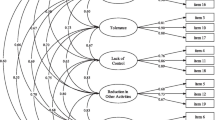Abstract
The objective of this study was to test the reliability and validity of a semistructured questionnaire concerning children’s experience of muscular tension and its relation to daily life experiences and pain. The reliability of the questions were tested by the test-retest method, and the answers were validated in a sample of children. The answers in the test-retest procedure were the same or had virtually the same content in 8 out of 9 children (κ = 0.80). When asked about the sensation of bodily tension, 38 out of 42 children, aged 7 to 15, said that they had experienced this sensation, and 32 of them could give a more detailed description of it using words likejittery, stiff, tight, andunpleasant. These 32 children could also describe where in the body they felt the tension: Abdomen, head, legs, and arms were common locations. Thirty-six children described how the tension was triggered by life experiences that had to do with stress. In 14 of the 42 children, the tension induced pain in the areas of the body where they experienced tension, such as the stomach and the head. Thus, in a small sample of children, a semistructured questionnaire showed acceptable reliability and validity. This indicates, preliminarily, that children over 6 years of age can identify the sensation, location, and inducing factors of bodily tension and its relation to pain and describe these experiences in personal words.
Similar content being viewed by others
References
Alfvén, G. (1997). Psychosomatic pain in children. A psychomuscular tension reaction?European Journal of Pain, 1, 1–10.
Alfvén, G. (1998). Letter to the editor.European Journal of Pain, 2, 189–190.
Damasio, A. (1999).The feeling of what happens. Body and emotion in the making of consciousness. New York: Harcourt.
Jensen, H., Andersen, H. O., Olesen, J., & Lindblom, U. (1986). Pressure-pain thresholdin human temporal region. Evaluation of a new algometer.Pain, 3, 313–323.
Johansson, H., & Sojka, P. (1991). Pathophysiological mechanism involved in genesis and spread of muscular tension in occupational muscle pain and in chronic musculoskeletal pain syndromes:Ahypothesis.Medical Hypothesis, 35, 196–203.
Lentz, F. A., Gracely, R. H., Romanoski, A. J., Hopem E. J., Rowland, L. H., & Dougherty, P. M. (1995). Stimulation in the human somatosensory thalamus can reproduce both affective and sensory dimensions of previously experienced pain.Nature Medicine, 9, 910–913.
Lundberg, U., Forsman, M., Zachau, G., Eklöf, M., Palmerud, G., Melin, B., et al. (in press). Effects of experimentally induced mental and physical stress on trapezius motor unit recruitment.Work & Stress.
Lundberg, U., Kadefors, R., Melin, B., Palmerud, P., Hassmén, M., Engström, M., et al. (1994). Psychophysiological stress and EMG activity of the trapezius muscular.International Journal of Behavioral Medicine, 1, 354–370.
McGrath, P. (1990).Pain in children. New York: Guilford.
Mense, S. (1993). Nociception from skeletal muscles in relation to clinical pain.Pain, 54, 241–289.
Author information
Authors and Affiliations
Corresponding author
Rights and permissions
About this article
Cite this article
Alfvén, G. Assessment of muscular tension in children. Int. J. Behav. Med. 10, 174–180 (2003). https://doi.org/10.1207/S15327558IJBM1002_06
Issue Date:
DOI: https://doi.org/10.1207/S15327558IJBM1002_06




